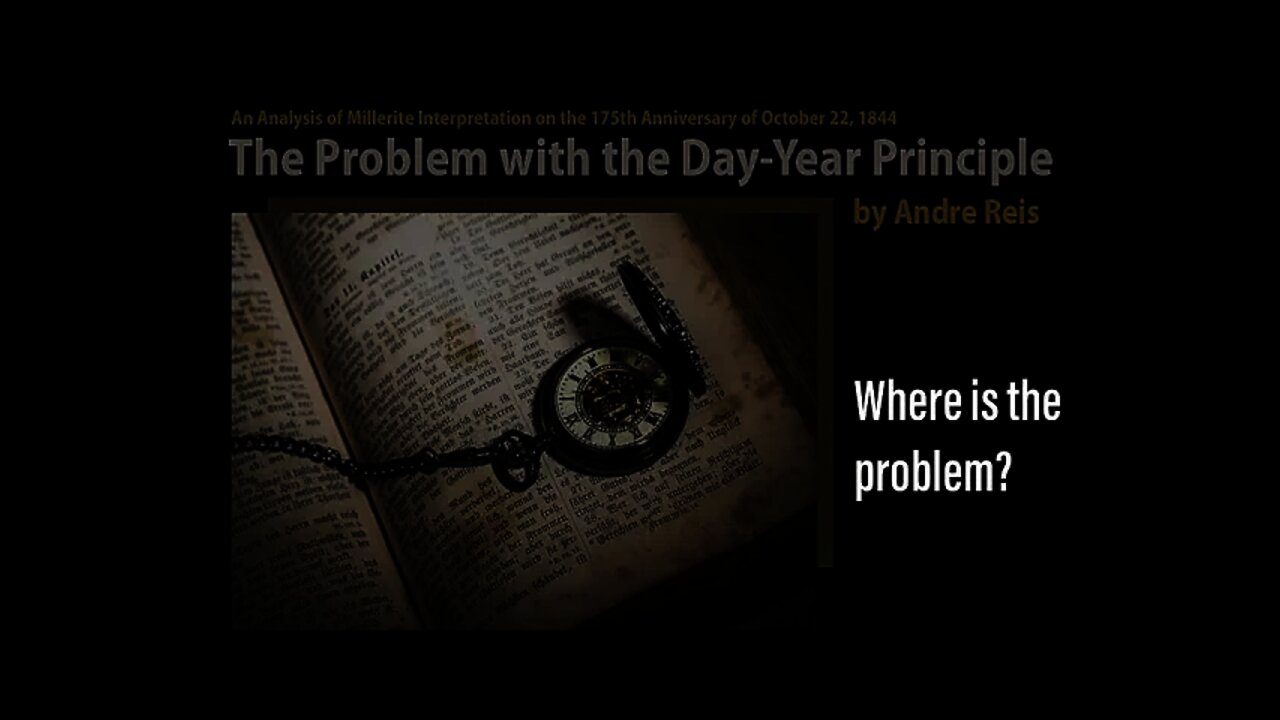Premium Only Content

Is there a " Problem with the Day-Year Principle" ? - Arthur Branner
Adventist Today posted an article entitled "The Problem with the Day-Year Principle "
https://atoday.org/the-problem-with-the-day-year-principle/
However, the Seventh Day Adventist view on this principle says that one day in prophetic Scripture is equal to one year of actual time. For example, the 2300 days in the prophecy of Daniel 8 actually play out as 2300 years in history.
Here are some verses in Scripture that point us to the day-year principle:
According to the number of the days in which you spied out the land, forty days, for each day you shall bear your guilt one year, namely forty years (Numbers 14:34 NKJV).
I have appointed thee each day for a year (Ezekiel 4:6).
Remember the days of old, consider the years of many generations: ask thy father, and he will shew thee; thy elders, and they will tell thee (Deuteronomy 32:7 ).
There are three primary precedents in Scripture that show the day-year principle:
1. Numbers 14:34. The Israelite's will wander for 40 years in the wilderness, one year for every day spent by the spies in Canaan.
2. Ezekiel 4:5-6. The prophet Ezekiel is commanded to lie on his left side for 390 days, followed by his right side for 40 days, to symbolize the equivalent number of years of punishment on Israel and Judah respectively.
3. Daniel 9:24-27. This is known as the Prophecy of Seventy Weeks. Read about the 70-week prophecy here. The majority of scholars do understand the passage to refer to 70 "sevens" or "septets" of years—that is, a total of 490 years.
This view was recognized by the Jews (Froom, L. E. (1950). Prophetic Faith of Our Fathers. 1 & 2. Review and Herald. pp. 889 and 124.) as seen in Daniel 9:24-27, and as seen in Jesus' use of the day-year principle in Luke 13 verses 31-33, and in the early church. (Froom, L. E. (1950). Prophetic Faith of Our Fathers 1. Review and Herald. pp. 170, 174–76.)
Protestant Reformers were well established on the day/year principle and it was also accepted by many Christian groups, ministers, and theologians.
Elliott, EB (1862). Horae Apocalypticae III (fifth ed.). p. 281.
du Ion, Francois (1596). The Apocalyps. p. 124.
Nigrinus. Antichrists Grundtliche Offenbarung. p. fils 28v,29r.)
Others who expounded the Historicist interpretation are John Wycliffe, John Knox, William Tyndale, Martin Luther, John Calvin, Ulrich Zwingli, Phillip Melanchthon, Sir Isaac Newton, Jan Huss, John Foxe, John Wesley, George Whitefield, Charles Finney, C. H. Spurgeon, Matthew Henry, Adam Clarke, Albert Barnes, and Bishop Thomas Newton as exponents of this school.
The day-year principle specifically applies to prophecy:
This day-year principle specifically applies to prophecy and is used for prophetic interpretation of "days" in prophecies. For example, historicist interpreters have usually understood the "time, times and half a time", "1,260 days" and "42 months" mentioned in Daniel and Revelation to be references to represent a period of 1260 years.
These time periods occur seven times in scripture:
Daniel 7:25, "time, times and a half".
Daniel 12:7, "time, times and a half".
Revelation 11:2, "42 months".
Revelation 11:3, "1260 days".
Revelation 12:6, "1260 days".
Revelation 12:14, "time, times and a half".
Revelation 13:5, "42 months".
-
 13:03
13:03
Light Channel TV
1 year agoRenee's Health Corner: The Importance of Eating Fruit & Vegetables
3071 -
 4:14
4:14
TheGreatOne44
3 years ago $0.10 earnedProblem With Polly "Freedom"
52 -
 27:46
27:46
Peter von Panda
3 years agoHere's The Problem With CostCo
14 -
 LIVE
LIVE
I_Came_With_Fire_Podcast
9 hours agoNew Years TERRORISM, Mexico trying to FAFO, and DARK MONEY to US Think Tanks
203 watching -
 1:47:40
1:47:40
Glenn Greenwald
5 hours agoThe Key Issues Determining the Trajectory of the Second Trump Administration: From Israel and Ukraine to Populism and Free Speech | SYSTEM UPDATE #382
52.3K34 -
 1:02:44
1:02:44
The StoneZONE with Roger Stone
3 hours agoRoger Stone Unveils His 16th Annual International Best and Worst Dressed List | The StoneZONE
20.4K3 -
 45:22
45:22
Kyle Rittenhouse Presents: Tactically Inappropriate
4 hours ago $0.97 earnedKyle Rittenhouse Presents: Tactically Inappropriate
22.4K14 -
 1:13:16
1:13:16
Patriots With Grit
4 hours agoThe Comedy of White Privilege & Government | A.J. Rice
16.5K1 -
 49:40
49:40
Havoc
8 hours agoWhat's 2025 Looking Like... | Stuck Off the Realness Ep. 23
37.8K2 -
 3:58:11
3:58:11
Nerdrotic
8 hours ago $5.73 earnedWOKE Hollywood Freak out, Cyber Truck Attack, 2025 BEGINS! | Friday Night Tights 335 w Benny Johnson
95.3K18